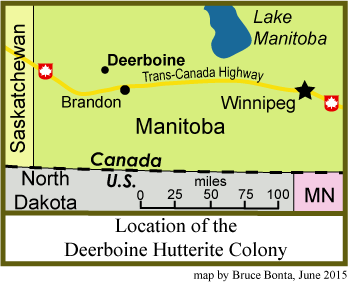Canadian photographer Tim Smith was roaming the prairies near his home in Brandon, Manitoba, when he spotted a group of Hutterite women working in one of the colony gardens. After he stopped to take some pictures of them, one of the young women pulled a phone out of her dress and took a photo of him taking pictures of them. He was fascinated that they had access to mobile phones.
 He visited their colony, Deerboine, located about 25 miles to the northwest of Brandon, the second largest city in the province and about 140 miles west of Winnipeg, the provincial capital. He was given permission to continue visiting and taking pictures. James Estrin, a photographer who works for the New York Times, described in his Times blog last Thursday Smith’s successes in developing a photo journal of Deerboine and several other nearby Hutterite colonies.
He visited their colony, Deerboine, located about 25 miles to the northwest of Brandon, the second largest city in the province and about 140 miles west of Winnipeg, the provincial capital. He was given permission to continue visiting and taking pictures. James Estrin, a photographer who works for the New York Times, described in his Times blog last Thursday Smith’s successes in developing a photo journal of Deerboine and several other nearby Hutterite colonies.
Mr. Smith commented that while the Deerboine minister, Tom Hofer, was not really interested in generating publicity, he was favorably inclined to letting the outside world know more about life inside the colonies. Smith gradually became friends with the Hutterites as he visited them again and again. After about six months of visiting, he learned that Mr. Hofer’s wife had just died in an automobile accident. Smith attended the funeral, sensed the grief of the colony, and found that he became much closer to the people afterwards.
According to the New York Times writer, Smith has visited Deerboine and the other colonies in that area of Manitoba hundreds of times, sometimes including his own wife and son in his visits. He is fascinated by the similarities, as well as the differences, between urban Canadian habits—he’s a native of Winnipeg—and the rural lives of the Hutterites.
He notes that in the colonies, people strive to conform: the men and women dress more or less alike in the clothing made by colony women. But he has observed instances of self-expression, particularly among the young people. He spotted brightly-colored hair clips, a hoodie, pink sneakers—articles the young people have bought in town. Smith indicates that colonies that are allowing the use of smartphones are finding the devices to be useful for colony businesses, but they are also fostering connections with the outside world.
The photos he includes in his own website—over 50 of them show his Hutterite friends—depict the daily lives of the people as only good photographs can do. They are dated from 2009 to 2015, and they range from charming to interesting to really moving. The first picture shows six children, four girls and two boys, leaping around on a huge pile of large, round hay bales, a late afternoon rainbow arching over their heads. Many of the photos show children playing, working, praying with the adults, and living much as children do everywhere.
Smith organizes his photos in his website into two groups, “Hutterites of Manitoba” and “Growing up Hutterite.” The first group includes pictures of Hutterites working hard together, socializing, having fun, and sharing family life. The spirit of most of the 25 or so images in the group are people doing things with one another.
For instance, in that first group, a couple photos show the elderly couple Ruth and John Waldner. One shows them praying before eating lunch, and Mr. Smith’s informative caption tells us that Ruth has dementia. In the second photo, he is tucking her into bed for an afternoon nap, and they are looking at one another affectionately. The photo captures beautifully, epitomizes, a lifetime of harmony together, under the umbrella of colony life and support.
The second group, “Growing up Hutterite,” concentrates on children and young people in the colonies. One photo shows five children playing in a colony swimming pond. Due to the shirts and bathing suits they are wearing, they look like any kids in mainstream society having fun. Another photo of young adults arm wrestling includes a number of young men and women gathered around a table, all grinning with the enjoyment of the contest.
And, to single out one more, Smith captured a priceless moment as a youngster runs to catch a Pekin duck in a narrow pen. The duck runs with his beak wide open and the boy is close behind, running with his mouth open too. Smith provides helpful captions under all his pictures. This one reads, “Simeon Wurtz tries to corner a duck while helping with the slaughter. Children are taught to pull their weight on the colony at an early age. Deerboine Colony – 2010.”